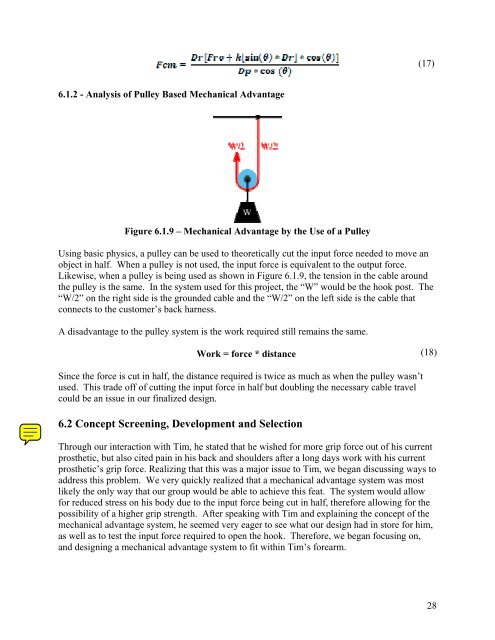Prosthetic Arm Force Reducer Team 1 – Halliday's ... - Ohio University
Prosthetic Arm Force Reducer Team 1 – Halliday's ... - Ohio University
Prosthetic Arm Force Reducer Team 1 – Halliday's ... - Ohio University
Create successful ePaper yourself
Turn your PDF publications into a flip-book with our unique Google optimized e-Paper software.
6.1.2 - Analysis of Pulley Based Mechanical Advantage<br />
Figure 6.1.9 <strong>–</strong> Mechanical Advantage by the Use of a Pulley<br />
Using basic physics, a pulley can be used to theoretically cut the input force needed to move an<br />
object in half. When a pulley is not used, the input force is equivalent to the output force.<br />
Likewise, when a pulley is being used as shown in Figure 6.1.9, the tension in the cable around<br />
the pulley is the same. In the system used for this project, the “W” would be the hook post. The<br />
“W/2” on the right side is the grounded cable and the “W/2” on the left side is the cable that<br />
connects to the customer’s back harness.<br />
A disadvantage to the pulley system is the work required still remains the same.<br />
Work = force * distance<br />
Since the force is cut in half, the distance required is twice as much as when the pulley wasn’t<br />
used. This trade off of cutting the input force in half but doubling the necessary cable travel<br />
could be an issue in our finalized design.<br />
6.2 Concept Screening, Development and Selection<br />
Through our interaction with Tim, he stated that he wished for more grip force out of his current<br />
prosthetic, but also cited pain in his back and shoulders after a long days work with his current<br />
prosthetic’s grip force. Realizing that this was a major issue to Tim, we began discussing ways to<br />
address this problem. We very quickly realized that a mechanical advantage system was most<br />
likely the only way that our group would be able to achieve this feat. The system would allow<br />
for reduced stress on his body due to the input force being cut in half, therefore allowing for the<br />
possibility of a higher grip strength. After speaking with Tim and explaining the concept of the<br />
mechanical advantage system, he seemed very eager to see what our design had in store for him,<br />
as well as to test the input force required to open the hook. Therefore, we began focusing on,<br />
and designing a mechanical advantage system to fit within Tim’s forearm.<br />
(17)<br />
(18)<br />
28

















